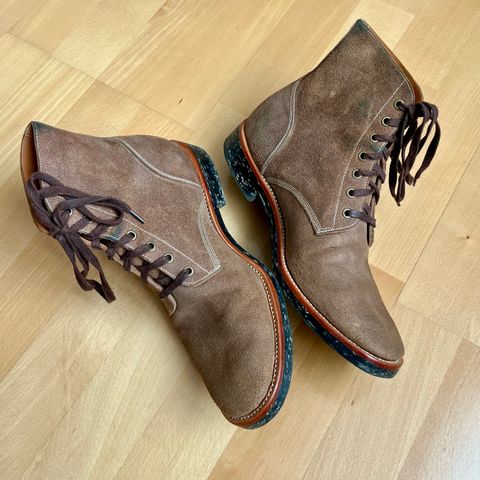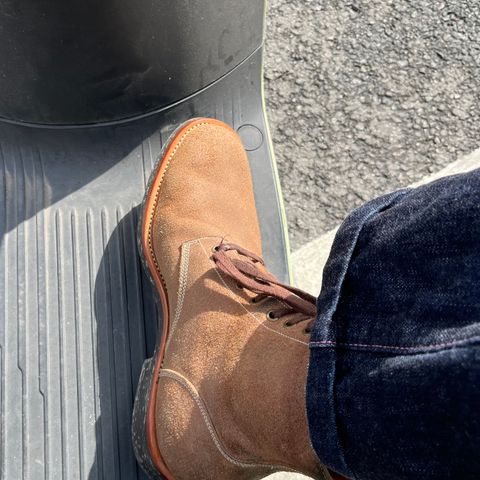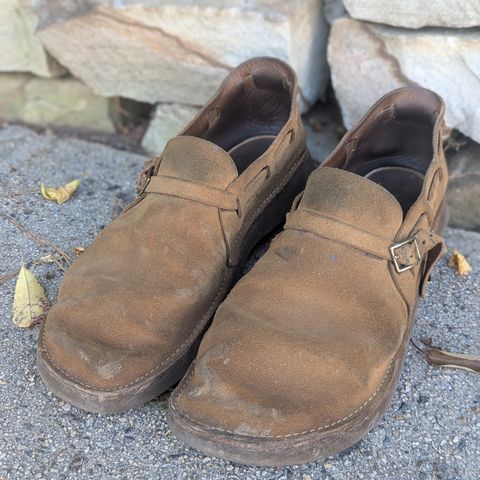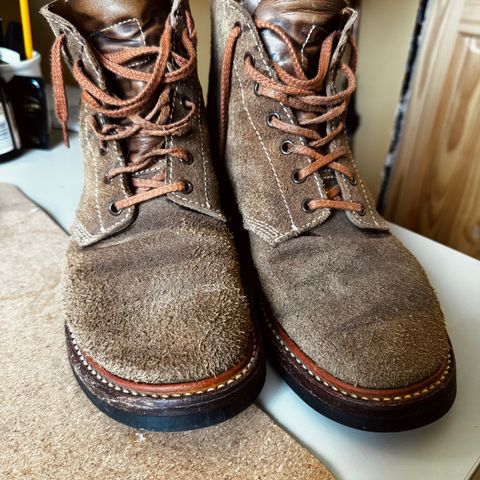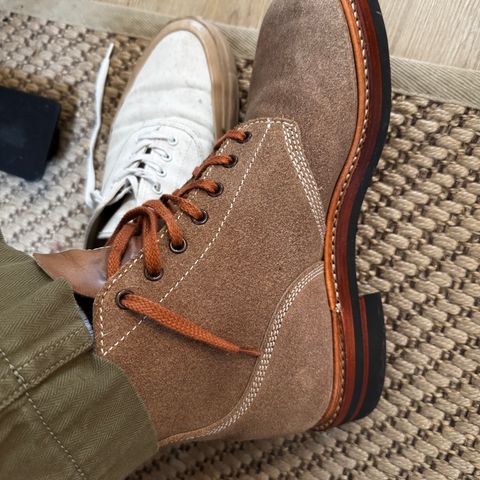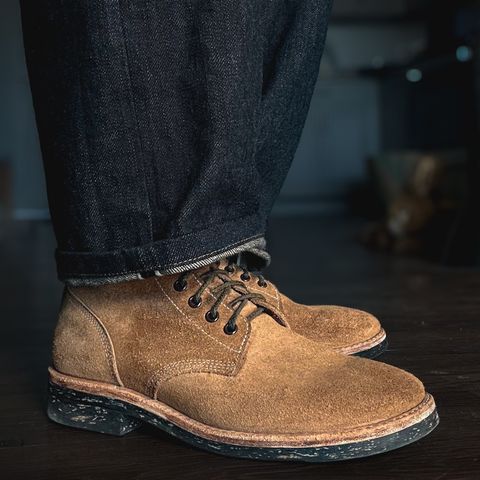About
Horween Chromexcel Roughout is a variation of Chromexcel leather produced by Horween Leather Company with the rough side facing outward. Similar to a rugged suede in texture but with a firmer hand, this leather combines the durability and oil-rich properties of traditional Chromexcel with the practical advantages of a roughout finish that develops a distinctive patina with wear.
About
Horween Chromexcel Roughout is a variation of Chromexcel leather produced by Horween Leather Company with the rough side facing outward. Similar to a rugged suede in texture but with a firmer hand, this leather combines the durability and oil-rich properties of traditional Chromexcel with the practical advantages of a roughout finish that develops a distinctive patina with wear.
Originally developed during World War II at the request of the Department of Defense for amphibious operations in the Pacific Theater, the leather was specifically engineered with water-resistant properties for military field boots. Known internally at Horween as "Marine Field Shoe" leather, this specialized tannage became available to civilian bootmakers and remains popular among heritage footwear manufacturers for its combination of ruggedness and aging characteristics.
Development and Military Origins
The Department of Defense approached Horween Leather Company during World War II to develop a roughout leather with enhanced water-resistant properties for military personnel engaged in the Pacific Theater's amphibious operations. The American "Island Hopping" strategy required boots that could withstand the extremely hot and humid conditions of South Pacific islands while providing protection during amphibious landings.
Horween's existing expertise in water-resistant leather production for industrial applications, including gaskets and washers, positioned the company to meet these military specifications. The resulting leather was designated under Department of Defense Specification 72-S-2 and issued in 1943 as part of the Field Shoes (N-1) program.
The specification called for "chrome tanned, flesh side out, natural cowhide" using a "chromium-sulfate tanning process to increase leather's resistance to water." While officially described in compliance with contractor protocol, the actual leather represented Horween's Marine Field Shoe tannage, which the company continues to reference on invoices today.
Manufacturing Process
Horween Chromexcel Roughout follows the same complex manufacturing process as regular Chromexcel leather, requiring 28 working days and at least 89 separate processes utilizing all five floors of Horween's Chicago facility. The leather begins with chrome tanning to create the characteristic blue "wet blue" stage, followed by vegetable retanning using proprietary bark extracts.
The distinguishing "hot stuffing" process impregnates the leather with a proprietary blend of natural oils, waxes, and greases that remain solid at room temperature. This treatment creates Chromexcel's signature "pull-up" effect, where the oils and waxes disperse and lighten the leather when pressed or stretched.
The finishing process includes multiple hand-rubbed coats of aniline finish followed by a final application of Neatsfoot oil. The key difference in roughout production lies in presenting the flesh side of the leather as the exterior surface, creating the characteristic suede-like texture while maintaining all of Chromexcel's underlying properties.
Physical Characteristics
Chromexcel Roughout exhibits a distinctive suede-like texture with a firmer hand than traditional suede materials. The leather maintains Chromexcel's characteristic pull-up effect, though this appears differently on the roughout surface compared to the smooth grain side.
The leather demonstrates greater resistance to visible scratches and scuffs compared to smooth Chromexcel leather. While smooth leather shows damage more readily, the roughout surface naturally camouflages minor wear marks and maintains a consistent appearance through daily use.
Color development occurs as the leather ages, with the natural tones deepening and developing a distinctive patina. The rough texture allows for gradual color saturation that enhances the leather's appearance over time while maintaining its structural integrity.
Available weights range from lighter options suitable for casual footwear to heavier specifications for work boots, with the same weight classifications as regular Chromexcel production from 2-3 oz horsefront applications up to 9-10 oz cowhide sections.
Care and Maintenance
Chromexcel Roughout requires significantly less maintenance than smooth Chromexcel leather due to its forgiving surface texture. The basic care regimen consists of cleaning with saddle soap, conditioning with boot oil, and applying leather grease for water resistance.
Unlike smooth Chromexcel, which benefits from regular polishing and careful treatment of surface marks, roughout leather naturally self-conditions through the oils and waxes incorporated during the hot stuffing process. The surface texture eliminates the need for frequent polishing or buffing that smooth leathers require.
The leather's water-resistant properties, inherited from its military development, reduce the frequency of conditioning treatments needed. Regular cleaning and occasional oiling maintain the leather's flexibility and appearance without the intensive care protocols required for more delicate leather types.
Heritage Footwear Applications
Multiple heritage footwear manufacturers utilize Horween Chromexcel Roughout for both work boots and casual footwear. Red Wing Heritage employs a proprietary version called Muleskinner leather, produced by the Red Wing-owned S.B. Foot Tanning Company, for their Classic Moc line and other heritage styles.
Oak Street Bootmakers features Natural Chromexcel Roughout in their Field Boot models, maintaining the connection to the leather's military heritage through traditional field boot patterns. Alden incorporates the leather into various boot styles within their extensive Horween leather offerings.
Viberg produces N-1 Field Boots using Natural Chromexcel Roughout, directly referencing the World War II naval specification that originally defined this leather type. Other specialty bootmakers continue to utilize this leather for both historical reproductions and contemporary designs that benefit from its durability and distinctive aesthetic characteristics.
The leather's popularity among work boot manufacturers stems from its practical advantages: enhanced scratch resistance, reduced maintenance requirements, and the ability to maintain a professional appearance through demanding use conditions while developing an attractive patina over time.
References
"Horween Chromexcel Roughout Leather". Oak Street Bootmakers. Retrieved September 5, 2025.
"Chromexcel". Horween Leather Company. March 23, 2010.
"The Attraction to Horween Chromexcel". Grantstone Shoes. Retrieved September 5, 2025.
"Roughout Leather Vs Smooth...Which Should I Get On My Boots?". Nicks Handmade Boots. Retrieved September 5, 2025.
"Heritage Boots". Red Wing Shoes. Retrieved September 5, 2025.
"N-1 Field Shoes Collection". Withered Fig. April 2024.
